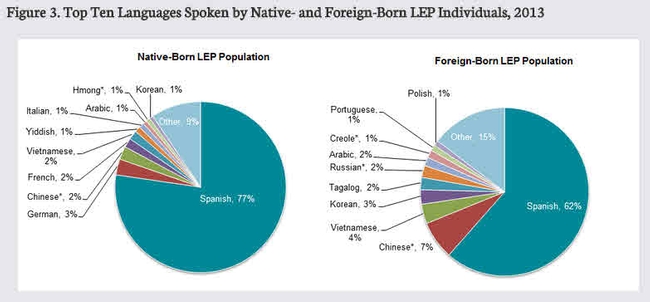The Limited English Proficient Population in the United States

Between 1990 and 2013, the LEP population grew 80 percent from nearly 14 million to 25.1 million (see Figure 1). The growth of the LEP population during this period came largely from increases in the immigrant LEP population. The most dramatic increase occurred during the 1990s as the LEP population increased 52 percent. The growth rate then slowed in the 2000s and the size of the LEP population has since stabilized. Over the past two decades, the LEP share of the total U.S. population has increased from about 6 percent in 1990 to 8.5 percent in 2013.
Immigrants to the United States come from many different language backgrounds and may be in various stages of English proficiency. Of the total immigrant population of 41.3 million in 2013, about half was LEP.
Compared to the English-proficient population, the LEP population was less educated and more likely to live in poverty. Employed LEP men in 2013 were more likely to work in construction, natural resources, and maintenance occupations than English-proficient men, while LEP women were much more likely to be employed in service and personal-care occupations than English-proficient women.
As of 2013, the highest concentrations of LEP individuals were found in the six traditional immigrant-destination states—California (6.8 million, or 27 percent of the total LEP population), Texas (3.4 million, 14 percent), New York (2.5 million, 10 percent), Florida (2.1 million, 8 percent), Illinois (1.1 million, 4 percent), and New Jersey (1 million, 4 percent). Together, the top six states accounted for approximately two-thirds of the LEP population.
Eleven states had a higher share of LEP residents than the nationwide proportion of 8 percent. California had the highest share, with LEP individuals accounting for 19 percent of the state population.
Nativity
The foreign-born population was much more likely to have limited English proficiency than the native-born population. In 2013, about 50 percent of immigrants (20.4 million) were LEP, compared to 2 percent of the U.S.-born population.
In 2013, 81 percent of LEP individuals were immigrants. Of the total foreign-born LEP population, 39 percent were born in Mexico, followed by China (6 percent), El Salvador (4 percent), Vietnam (4 percent), Cuba (3 percent), and the Dominican Republic (3 percent). Foreign-born LEP individuals were less likely than the overall immigrant population to be naturalized citizens (36 percent versus 47 percent, respectively).
Of native-born LEP individuals, 14 percent were born in Puerto Rico and less than 2 percent were born in Mexico to at least one U.S.-citizen parent. Three percent were born abroad elsewhere to at least one U.S.-citizen parent, with the remaining 82 percent born in one of the 50 U.S. states or the District of Columbia.
Language Diversity
Spanish was the predominant language spoken by both immigrant and U.S.-born LEP individuals. About 64 percent (16.2 million) of the total LEP population spoke Spanish, followed by Chinese (1.6 million, or 6 percent), Vietnamese (847,000, 3 percent), Korean (599,000, 2 percent), and Tagalog (509,000, 2 percent). Close to 80 percent of the LEP population spoke one of these five languages.
There were marked differences, however, in the top languages spoken by LEP persons by nativity. 3, 77 percent (3.6 million) of the U.S.-born LEP population spoke Spanish, followed by German (140,000, or 3 percent), Chinese (116,000, 2 percent), French (82,000, 2 percent), and Vietnamese (80,000, 2 percent). Spanish was also the predominant language, spoken by about 62 percent (12.5 million) of immigrant LEP individuals. However, Asian languages were more likely to be spoken by the foreign-born LEP population, including Chinese (1.5 million, or 7 percent), Vietnamese (767,000, 4 percent), Korean (564,000, 3 percent), and Tagalog (484,000, 2 percent).
Age, Race, and Ethnicity
Compared to their English-proficient counterparts, LEP individuals were much less likely to be of school age and much more likely to be of working age. In 2013, 10 percent of LEP individuals were children between the ages 5 and 17, versus 19 percent of the English-proficient population.
LEP individuals were much more likely to be Latino or Asian than their English-proficient counterparts. While Latinos comprised 63 percent of the LEP population, they accounted for only 12 percent of the English-proficient population. Likewise, 21 percent of LEP individuals were Asian compared to only 4 percent of English-proficient individuals.
Education and Employment
In general, LEP adults were much less educated than their English-proficient peers. As of 2013, 46 percent of all LEP individuals ages 25 and over had no high school diploma compared to 10 percent of their English-proficient counterparts. About 14 percent of LEP adults had a bachelor's degree or higher, compared to 31 percent of English-proficient adults.
LEP Children and English Language Learners
In 2013, of the 51.3 million children ages 5 to 17 in the United States, approximately 8 million (16 percent) lived with at least one LEP parent.
Among the 2.3 million children who were themselves LEP, 23 percent were foreign born. The remaining 77 percent (1.8 million) were U.S. born, with 77 percent (1.4 million) having at least one immigrant parent.
Source: Migration Policy Institute, The Limited English Proficient Population in the United States, July 8, 2015.
